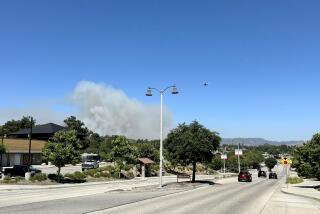Searching for a Pulse in Simi Valley
I drove up to Simi Valley the other day to see if the city had acquired a heart.
I had received a letter from Vicky Howard, city councilwoman, reminding me that I had written a column several years ago in which I said that my wife and I had stopped in Simi Valley (I can no longer remember why) and not only couldn’t find a downtown (or heart); we couldn’t even find a restaurant.
“That column has stayed in my memory,” wrote Howard, “because, unfortunately, you were correct. The city’s growth had been somewhat Topsy-like and it had not developed a central core, although I would never agree that Simi Valley lacked a heart .”
All that had changed, she said; she invited me to drive up and see, and to have lunch in one of several class restaurants.
Simi Valley lies between two rocky mountain ranges about 45 minutes northwest of downtown Los Angeles over the Golden State and Simi Valley freeways. Howard had sent me a map directing me to the new City Hall. It was a cylinder with wings, in the pervasive earthen color. I walked in. Four women sat working behind four public counters. I was the only non-employee in the place. A woman at the information counter directed me to the nearby City Council rooms. The door was open. Inside I found one person, evidently a secretary. She said Vicky Howard was due shortly.
Shortly, Howard arrived with a man she introduced as Lin Koester, city manager. We got into Koester’s car to tour the city, first checking out the nearby library, a cheerful senior-citizen center and a large park. Howard said an arts center would soon be built on vacant land behind the City Hall.
We drove past spacious parks and blocks of houses, apartments and condominiums with luxuriant yards. I asked what the houses cost. “Four hundred (thousand) to $600,000,” Koester said. “Absolute minimum, $250,000.”
Simi Valley has an area of 35 square miles and a population of 100,000, of which 80% are Anglo. The average household size is 3.3 persons; and 84% own their homes. Most adults commute, working in Los Angeles. Simi Valley has more cars per household (2.23) than any other city in the nation. But the city now has a dozen new high-tech industries and several financial headquarters in landscaped parks.
We drove down automobile row past hundreds of new cars displayed in front of Taj Mahal showrooms, through blocks of shopping malls with all the familiar names: Denny’s, Reuben’s, Shell, Union, Mervyn’s, Payless, Home Savings, Mann’s (six theaters).
Perhaps this was the center of the city. The Police Department was nearby, in the former City Hall. I asked about crime. “We’ve had one bank holdup in two years,” Koester said. Until Thousand Oaks beat it out, Simi Valley had the lowest crime rate in the nation. “Burglaries are our biggest problem.”
We visited Strathearn Park, where the Victorian ranch house built by R. P. Strathearn stands, attached to an adobe from the pre-1800 Mexican rancho era. Nearby stands a neat two-story Colony house, one of 12 prefabs built in Chicago and shipped to Simi to form the historic pre-fab Colony.
We transferred to a pickup for a jarring ride to a peak in the Simi Hills on which the Ronald Reagan Museum will stand. Howard assured me that on a clear day one could see the ocean. We did see thousands of red-tile-roofed beige houses clustered tightly in huge islands afloat in a sea of green. This was the Wood Ranch development--38,000 homes on 40 acres, and more building every day.
We had lunch at the Wood Ranch Country Club. It was a pleasant setting overlooking the fairways, and the clam chowder was excellent. I doubted, though, that the club could be considered the “heart” of Simi Valley. Not with a membership fee of $18,500, lifetime $60,000.
Nancy Bender, director of the Chamber of Commerce, and Bob Hunt, assistant city manager, joined us at lunch. I learned that Simi Valley had no adult bookstores, no X-rated movie houses, no massage parlors and no abortion clinics. I asked if they had a McDonald’s.
Yes, they had a McDonald’s, but no Jack in the Box. They wouldn’t allow that big Jack in the Box sign.
I’m not sure that Simi Valley has a center yet, but it does have a heart.
More to Read
Sign up for Essential California
The most important California stories and recommendations in your inbox every morning.
You may occasionally receive promotional content from the Los Angeles Times.









